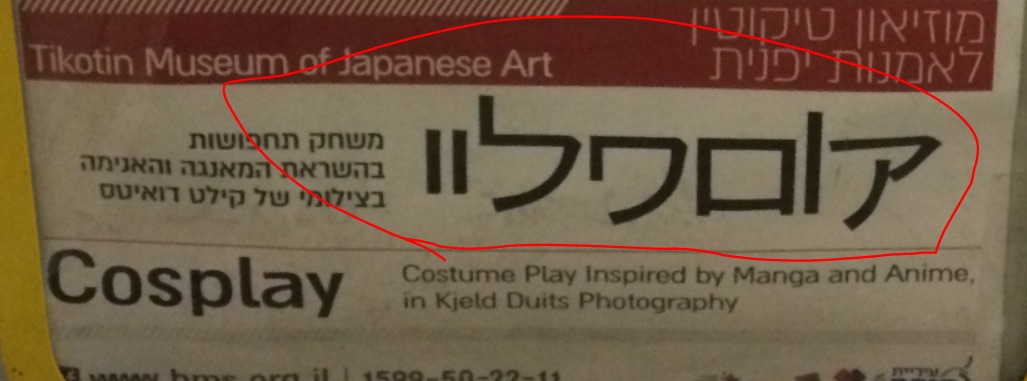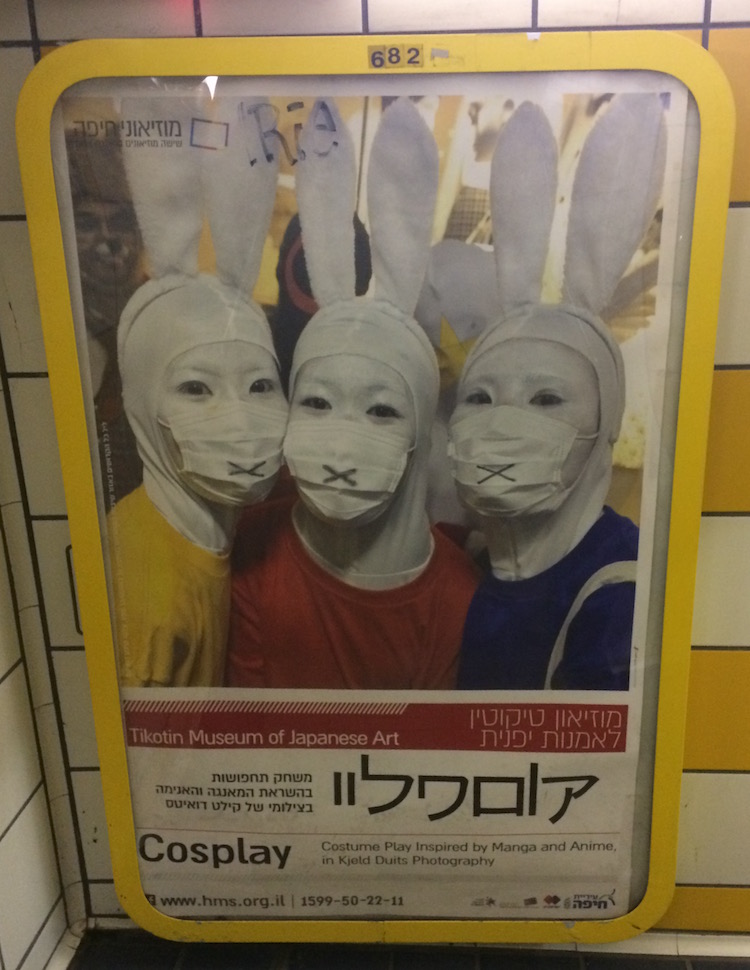Multiscriptal cosplay poster in Haifa
« previous post | next post »
Guy Almog sent me this photograph of a detail from a poster that he and I spotted at several places in and around the Haifa subway:
This is the full, unedited poster:
Here we find katakana being used to write in Hebrew a Japanese word that came from two English words, an impressive round-tripper that probably made its circuit in at most 40 years or so: En. cosplay < Jp. abbr. kosupure コスプレ < Jp. kosuchūmupurē コスチュームプレー < En. costume play. Thus, now it's back in English as a borrowing from the Japanese portmanteau. As Guy explained to me, the katakana on the poster is being used to write what is supposed to be קוספליי, the Hebrew transcription for cosplay / コスプレ.
This ingenious wordplay (wādopure ワードプレ or just wāpure ワープレ [cf. the native Japanese term kotoba asobi 言葉遊び], both of which I just made up on the analogy of wādopurosessa ワードプロセッサ or just wāpuro ワープロ ["word processor"] for fun) is on a promotional poster for the Tikotin Museum for Japanese Art, which was very close to the hotel where I was staying in Haifa, the Dan Panorama.
For some other recent posts on multiscriptalism in Israel, see:
- "Apostrophe in Hebrew" (11/22/16)
- "More biscriptal examples from Israel" (12/12/16)


Kaleberg said,
January 1, 2017 @ 11:58 pm
I wonder how many people recognize that the alphabet being used isn't Hebrew?
Kaleberg said,
January 2, 2017 @ 12:02 am
Jews have used the Hebrew alphabet to write versions such languages as German, English and Spanish. Berenice Abbot took a number of photos of Hebrew lettering spelling English words, notably her photos titled "Men's Furnishings" and "Chicken Market". If more Jews had settled in Japan perhaps we would have seen more Japanese written using Hebrew letters.
Vanya said,
January 2, 2017 @ 8:10 am
No, I would argue that is Hebrew, just in a font that looks like katakana. It makes no sense to a Japanese speaker, but I assume a Hebrew speaker, without any familiarity with Japanese, can read the word easily. And three of the characters are not part of the kana set.
V said,
January 2, 2017 @ 8:44 am
I agree with Vanya that this can't be said to be "biscriptal" if it has no meaningful content (and indeed is really distracting and offputting) to readers of one of the scripts in question. At best, to Japanese-literate eyes it looks as if it says フワロア "fuwaroa", which is not a word.
Separately, the Japanese Wikipedia article for 言葉遊び mentions that the term has a secondary, negative meaning that the English "wordplay" does not: as a derogatory term for confusing or nonsensical talk (支離滅裂な詭弁や戯言). I wonder how the term evolved, considering that it looks suspiciously like a calque of English "wordplay" to me (but don't have the time/resources to confirm or reject whether it is at the moment).
david said,
January 2, 2017 @ 11:34 am
It's not biscriptal, it's Hebrew קוספליי lettered in a katakana-esque font. I've seen it done in cartoons for English readers using pseudo-hebrew characters or pseudo-kanji. Cosplayers are probably familiar with this sort of thing.
jo lumley said,
January 2, 2017 @ 12:52 pm
Any thoughts on why the vav ו is rather long? (I mean, that it starts almost as high as the lamed ל does.) If it's supposed to look more 'Japanese' that way, it's not very successful, since Japanese script is lacking in ascenders and descenders. Or perhaps this is not unusual after all?
Speaking of which, it's also noticeable that the ア (katakana 'a') is placed rather low to mimic the descender of qof ק. As is ワ (katakana 'wa'), but for unclear reasons, since to my eye pe פ (non-word-finally) is normally level with the baseline.
Jonathan said,
January 2, 2017 @ 1:16 pm
"And three of the characters are not part of the kana set." Thank you, Vanya. I was going a little crazy trying to remember what katakana character the lamed corresponded to.
Guy A said,
January 2, 2017 @ 3:40 pm
@ jo Lumley, maybe the “ו” is long as to represent the O sound (holam)? That is, “וֹ” as in “קוֹסְפְּלֵיְי”? Or maybe it is indeed just a way to make this word look more exotic and mysterious? Probably the latter.
Also, the two “י” in the end reminds me the upper part of ツ in certain fonts.
Oh, and regarding the "ל" – maybe we can compare it to the stroke “㇉” that appears in some kanji such as 亏, 号, 弓 etc.
At any rate, this wordplay (or whatever you may call it) is far from perfect, but when Hebrew speakers see it next to the English “Cosplay” they can decipher it.
BTW, the best “wordplay” between katakana and Hebrew letters I know of is the word アメリカ Amerika [America]. For speakers of Hebrew with no knowledge of Japanese this may look like the word “מניאק” which is a borrowing of the word “maniac”, but actually means something like “douchebag”.
Keith Rhodes said,
January 2, 2017 @ 3:57 pm
@V
Oh yes it can!
It uses Latin and Hebrew scripts.
I think you meant that it can't be said to be "triscriptal", i.e., not Latin + Hebrew + Katakana.
mark said,
January 2, 2017 @ 4:05 pm
I was going to ask, where is the katakana in this poster, since it looked like Hebrew letters to me. Is it not a Hebrew transliteration of the Japanese word?
jo lumley said,
January 2, 2017 @ 4:33 pm
Guy A: interesting about וֹ, I never thought of that.
Even more than the bottom of 号, the ל there looks to me like フ (katakana 'fu') with an extra vertical stroke.
Andrew (not the same one) said,
January 2, 2017 @ 6:13 pm
I'm reminded of the way English is sometimes written in such a way as to give the impression of Greek or Russian; this is very annoying to those who can actually read Greek or Russian, as the letters are given values that do not make sense. (E.g, in 'Russian', reversed R is used for R, not for 'ya'; reversed N is used for N, not for 'i'. In 'Greek', sigma is used for 'E', as in the famous film MY BIG FAT GRSSK WEDDING.)
anhweol said,
January 3, 2017 @ 4:32 am
Re 'Greek'; I remember a poster advertising trips to Greece promising "Ηεανεη". I don't seem to be able to find Ieanei on the map…
Keith said,
January 3, 2017 @ 10:51 am
Seeing Greek or Cyrllic letters interspersed with Latin letters usually annoys me.
However, there is a brand of yoghurt here in France whose name but especially the style of writing it on packaging, pleases me no end.
The first few dozen times that I saw the advertising posters in the street, I read the name as Greek letters "γορα", but that looks like a Slavic word for "mountain", so conjured up in my mind bucolic scenes of goats or sheep in mountain meadows.
In fact, it is supposed to be read as the latin letters "Yopa".
https://www.yoplait.fr/wp-content/uploads/2016/04/yopa.png
Rodger C said,
January 3, 2017 @ 1:05 pm
I've seen Hebrew cursive written with vavs like that, I suppose due to a desire to clarify the script by creating ascenders and descenders. Am I to infer that this is so rare many people don't recognize it?
Guy A said,
January 3, 2017 @ 2:15 pm
@Rodger C:
"I've seen Hebrew cursive written with vavs like that, I suppose due to a desire to clarify the script by creating ascenders and descenders. Am I to infer that this is so rare many people don't recognize it?"
Nah, everyone can recognize this as a vav… it just looks a bit weird, not cursive (just out of curiosity, how would you define “cursive Hebrew”? Is it any kind of handwritten variant or just the ones written with the characters joined? The latter are extremely uncommon).
Rodger C said,
January 3, 2017 @ 2:24 pm
Guy A, thanks. I did pause a moment before writing "cursive." I simply meant handwritten as opposed to "square Hebrew."
Jongseong Park said,
January 10, 2017 @ 8:49 am
Calling it "Cursive Hebrew" is fine. Cursive doesn't have to mean that the letters are connected, just that the strokes are written in a flowing manner.